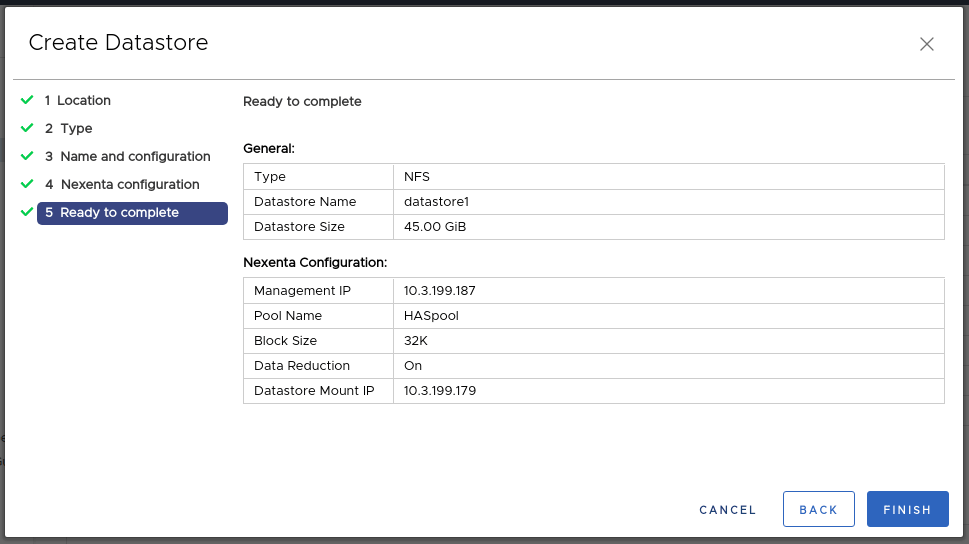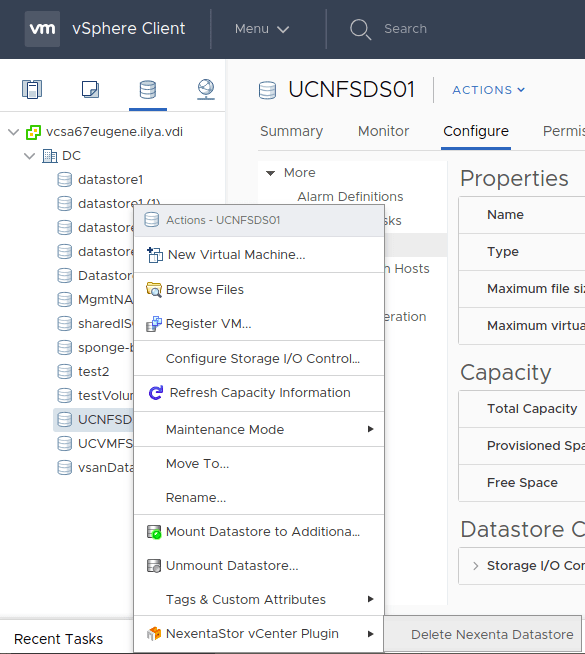Managing Datastores
Depending on your storage needs, you can create a datastore on the following types: NFS (version 3) or VMFS (iSCSI / FC). You can set up VMFS datastores on any SCSI-based storage devices that the host discovers. Datastores can be created either on a single ESXi host or on an ESXi Cluster.
Prerequisites
Prior to creating or deleting datastores, verify that the following prerequisites are met:
- Create targets and a target group, as described in Preconfiguring iSCSI for creating Volumes and VMFS/NFS Datastores
- You must have at least one pool configured. This was most likely done during the initial configuration of NexentaStor 5.3. For more informationm, see the NexentaStor 5.3 CLI Reference Guide
- For VMFS datastore creation, verify that the requirements are met:
- Fiber Channel (FC) Requirements:
- Configure targets using NexentaStor CLI or API or using the NexentaFusion UI
- Configure target groups in the NexentaStor appliance
- Configure ESXi FC Initiator are configured
- Discover FC targets
- iSCSI Requirements:
- Configure targets on the NexentaStor appliance
- Configure target groups in NexentaStor
- Optional: Configure host groups in NexentaStor
- Configure ESXi iSCSI initiator
- Discover iSCSI targets
- Fiber Channel (FC) Requirements:
Creating Datastores
After verifying that the necessary Prerequisites have been met, go to the vSphere Client Home page to create a datastore.
To create a datatore, do the following:
- Go to the Home page and click Hosts and Clusters in the right pane
- Right-click the host or cluster on which the datastore is to be created, and select NexentaStor vCenter Plugin from the drop-down list
- Click Create Datastore
- Select the Location of the datastore, then select NFS Datastore for NFS or VMFS Datastore for NexentaStor zvols provisioned through iSCSI or FC
- Select the NexentaStor appliance from which to provision the datastore, then select the pool to be provisioned as a datastore
- Select the size for this datastore. For SAN and NAS datastores, select the size of blocks for files in a dataset
- Enable or disable Data reduction by toggling it ON or OFF
- For an NFS datastore, select the IP address through which to mount the datastore. If a pool selected for provisioning as datastore is under HA protection, the VIP is chosen automatically and you are not allowed to edit it
- Click Next, move through the menus, filling in the appropriate fields
- Click Finish

When you delete a datastore using the NexentaStor vCenter Plugin, you not only delete the datastore but also take care of other cleanup, such as unsharing datasets and deleting file systems and volumes.
Deleting Datastores
To delete a datastore, do the following:
- Go to the Home page and click the Storage icon in the right pane
- Right-click the datastore to be deleted, and select NexentaStor vCenter Plugin from the drop-down list
- Click Delete Nexenta Datastore, and then click OK


